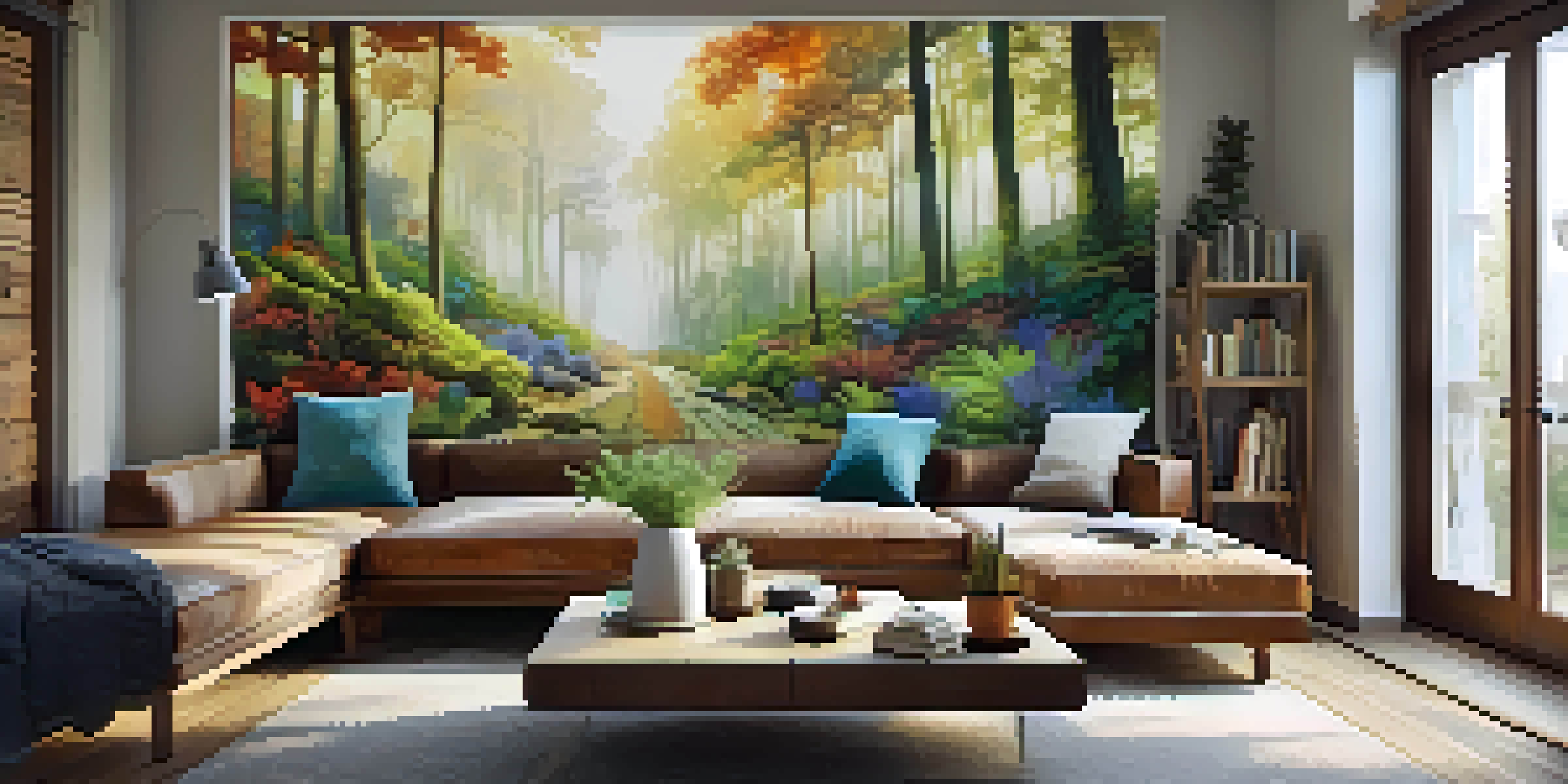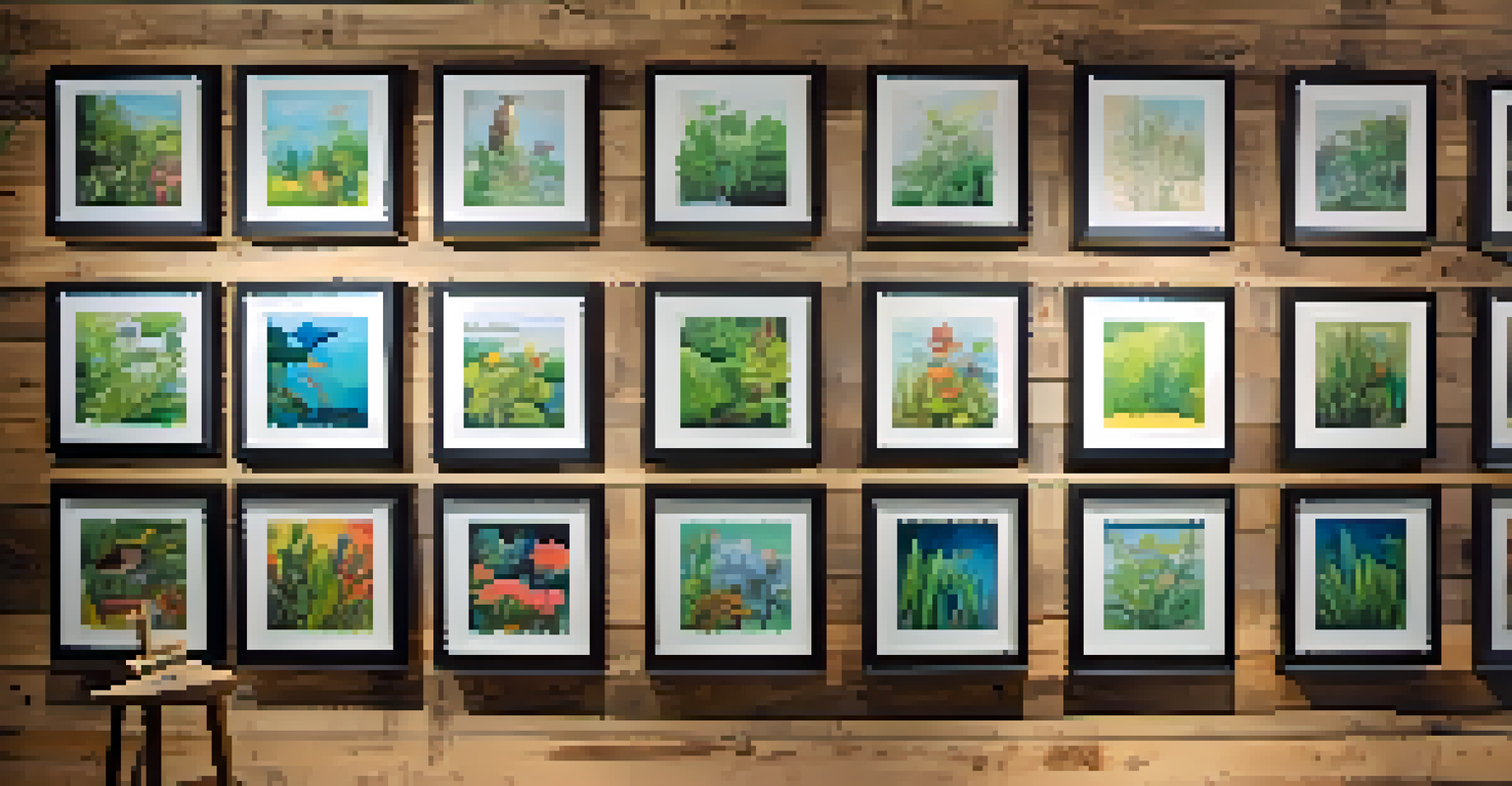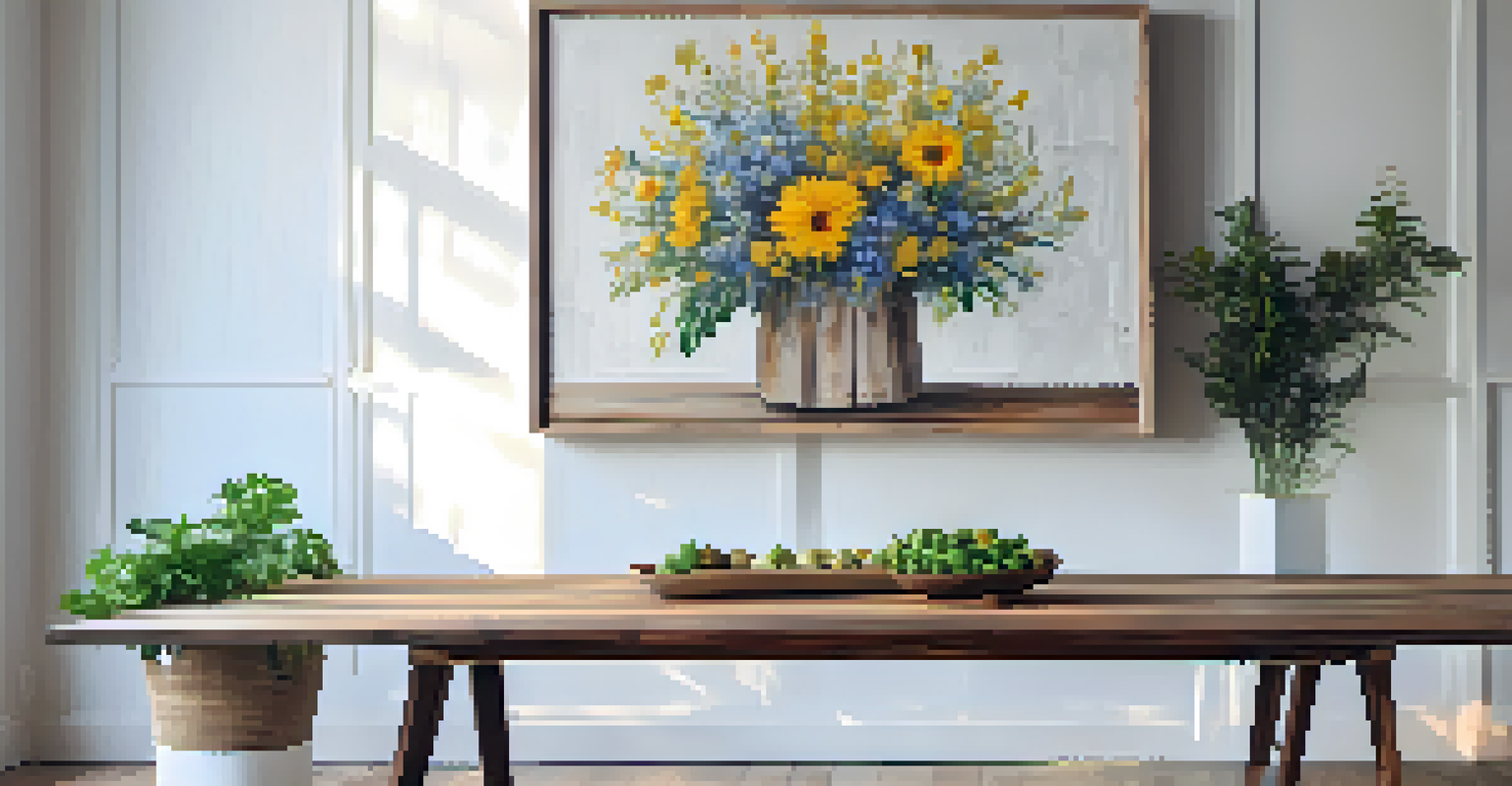Integrating Art into Sustainable Home Design

The Importance of Art in Sustainable Design
Art plays a crucial role in sustainable home design, adding aesthetic value while promoting eco-friendly practices. It helps create spaces that resonate with homeowners’ values, fostering a deeper connection to the environment. By incorporating art, designers can transform a standard living space into a vibrant, mindful sanctuary that inspires sustainable living.
Art is not a luxury; it is a necessity for sustainable living.
Moreover, art can serve as a conversation starter, raising awareness about sustainability issues and encouraging homeowners to reflect on their consumption habits. A beautifully crafted piece made from recycled materials, for instance, can highlight the importance of reusing resources while also serving as a stunning focal point in the home. This blend of beauty and purpose is what makes art an essential element in sustainable design.
Ultimately, integrating art into home design not only enhances the aesthetic appeal but also promotes a lifestyle that values ecological responsibility. When art and sustainability intersect, they create a unique narrative that encourages individuals to think critically about their choices and the impact of their living environment.
Choosing Eco-Friendly Materials for Art
Selecting the right materials is vital when integrating art into sustainable home design. Artists are increasingly turning to eco-friendly materials, such as reclaimed wood, recycled metal, and organic paints, which minimize environmental impact. By choosing these materials, homeowners can ensure that their art not only looks great but also aligns with their sustainability goals.

For instance, a sculpture made from repurposed materials not only reduces waste but also adds a unique character to the space. Each piece tells a story, showcasing creativity while promoting a message of reuse and recycling. This thoughtful approach to material selection can elevate the overall design and reinforce the commitment to sustainability.
Art Enhances Sustainable Design
Incorporating art into home design adds aesthetic value while fostering a deeper connection to eco-friendly practices.
Additionally, investing in local artists who utilize sustainable practices supports the community and reduces the carbon footprint associated with shipping. When you purchase art that embodies ethical production methods, you contribute to a larger movement that prioritizes both artistry and environmental stewardship.
Incorporating Nature-Inspired Art
Nature-inspired art can bring the beauty of the outdoors inside, creating a harmonious atmosphere in sustainable home design. This type of artwork often reflects natural forms, colors, and patterns, enhancing the connection between the home and its surrounding environment. By incorporating such pieces, homeowners can evoke a sense of tranquility and promote well-being.
Creativity is the power to connect the seemingly unconnected.
For example, a large mural depicting a serene forest scene can create an immersive experience, making the indoor space feel more expansive and connected to nature. This not only beautifies the home but also serves as a reminder of the importance of preserving our natural landscapes. Such art can inspire a greater appreciation for sustainability and encourage eco-friendly behaviors.
Moreover, nature-themed art can also serve as a platform for environmental advocacy. Artists often use their work to highlight pressing ecological issues, raising awareness and prompting action among viewers. By choosing art that reflects these themes, homeowners can create spaces that inspire change and foster a commitment to environmental responsibility.
Functional Art: Blending Utility and Aesthetics
Functional art is an innovative way to integrate creativity and practicality into sustainable home design. This type of art serves a purpose beyond mere decoration, providing everyday utility while enhancing the aesthetic value of a space. Think of beautifully designed furniture or lighting fixtures that are both visually striking and environmentally friendly.
For instance, a handcrafted table made from reclaimed materials not only serves as a centerpiece but also showcases the beauty of sustainable craftsmanship. Such pieces often become conversation starters, sharing stories about the materials used and the artist's vision. This functional approach to art can make a home feel more personalized and inviting.
Eco-Friendly Materials Matter
Choosing sustainable materials for art not only reduces environmental impact but also enhances the uniqueness of each piece.
Additionally, functional art can encourage sustainable practices by incorporating elements like energy-efficient lighting or water-saving designs. By selecting pieces that fulfill practical needs while embodying artistic expression, homeowners can enjoy a harmonious blend of beauty and functionality in their living spaces.
The Role of Local Artists in Sustainable Design
Supporting local artists is an integral part of integrating art into sustainable home design. When homeowners choose to purchase artwork from local creators, they contribute to the community's economy while reducing transportation-related environmental impacts. This practice not only fosters a sense of community but also encourages artistic expression that reflects local culture and values.
Local artists often draw inspiration from their surroundings, creating pieces that resonate with the environment and the people who inhabit it. When their work is incorporated into home design, it captures the essence of the area and creates a deeper connection between the space and its location. This can lead to a more meaningful living experience for homeowners.
Moreover, collaborating with local artists can result in unique, tailor-made pieces that fit the homeowner's vision while promoting sustainability. These partnerships can lead to innovative designs that incorporate recycled or upcycled materials, making a lasting impact on both the home and the community.
Creating a Sustainable Art Display at Home
Establishing a sustainable art display in your home involves thoughtful curation and creative presentation. Start by selecting pieces that resonate with your values, whether they emphasize environmental themes or utilize eco-friendly materials. Curating your collection with intention allows you to showcase art that inspires and aligns with your commitment to sustainability.
In addition to the artwork itself, consider how you display it. Using reclaimed frames, hanging systems made from sustainable materials, or even creating a gallery wall with a mix of art and plants can enhance the visual appeal while staying true to eco-friendly principles. This approach not only draws attention to the art but also creates a cohesive and inviting atmosphere.
Support Local Artists for Impact
Purchasing from local artists promotes community engagement and reflects local culture while encouraging sustainable practices.
Finally, regularly rotating your art display can keep your space fresh and exciting while promoting local artists. By changing up the pieces on display, you give more artists a chance to shine and keep the conversation around sustainability alive. This dynamic approach to showcasing art can turn your home into a living gallery that reflects your values and engages visitors.
The Future of Art in Sustainable Home Design
The future of art in sustainable home design looks promising as more artists and homeowners embrace eco-friendly practices. As the demand for sustainable living continues to grow, artists will likely innovate new ways to integrate art into design that prioritize both beauty and ecological responsibility. This synergy between art and sustainability can lead to exciting developments in how we view and create our living spaces.
Emerging technologies, such as 3D printing and digital art, also offer new avenues for sustainable artistic expression. Artists can experiment with materials and methods that minimize waste while producing stunning, one-of-a-kind pieces. This evolution not only enriches the art community but also encourages a shift in consumer habits towards more sustainable choices.

As we move forward, the integration of art in sustainable home design will likely become a defining feature of modern living. By continuing to prioritize creativity and environmental stewardship, we can create spaces that are not only functional but also deeply connected to the world around us, inspiring future generations to embrace sustainability through art.